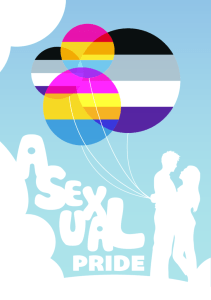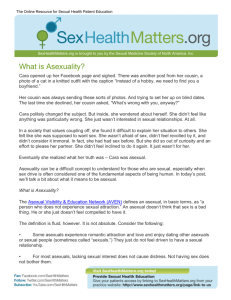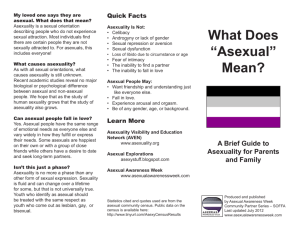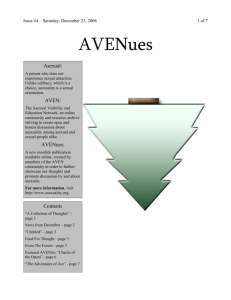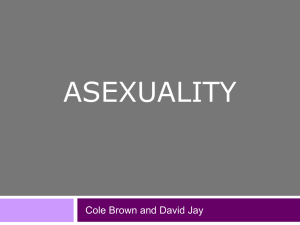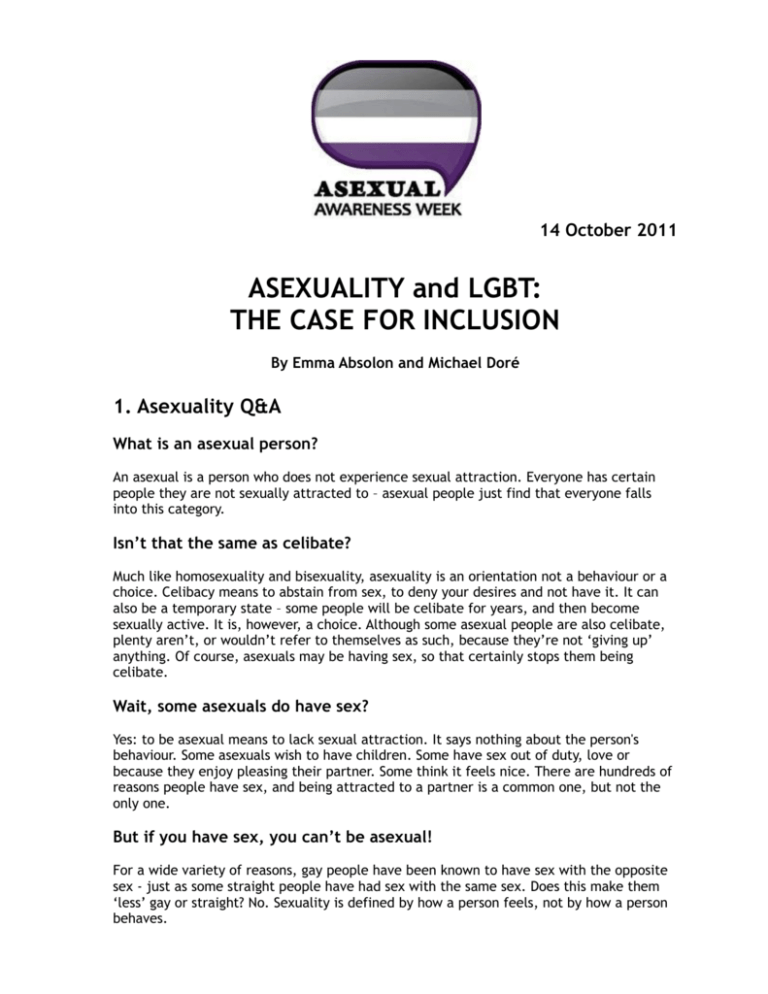
14 October 2011
ASEXUALITY and LGBT:
THE CASE FOR INCLUSION
By Emma Absolon and Michael Doré
1. Asexuality Q&A
What is an asexual person?
An asexual is a person who does not experience sexual attraction. Everyone has certain
people they are not sexually attracted to – asexual people just find that everyone falls
into this category.
Isn’t that the same as celibate?
Much like homosexuality and bisexuality, asexuality is an orientation not a behaviour or a
choice. Celibacy means to abstain from sex, to deny your desires and not have it. It can
also be a temporary state – some people will be celibate for years, and then become
sexually active. It is, however, a choice. Although some asexual people are also celibate,
plenty aren‟t, or wouldn‟t refer to themselves as such, because they‟re not „giving up‟
anything. Of course, asexuals may be having sex, so that certainly stops them being
celibate.
Wait, some asexuals do have sex?
Yes: to be asexual means to lack sexual attraction. It says nothing about the person's
behaviour. Some asexuals wish to have children. Some have sex out of duty, love or
because they enjoy pleasing their partner. Some think it feels nice. There are hundreds of
reasons people have sex, and being attracted to a partner is a common one, but not the
only one.
But if you have sex, you can’t be asexual!
For a wide variety of reasons, gay people have been known to have sex with the opposite
sex - just as some straight people have had sex with the same sex. Does this make them
„less‟ gay or straight? No. Sexuality is defined by how a person feels, not by how a person
behaves.
Isn't the word 'asexual' wrong anyhow? I thought it meant splitting in
half, like an amoeba.
You're thinking of asexual reproduction. The word asexual (a-sexual) literally means "not
sexual". It can be used to describe reproduction without the fusion of gametes, but that
isn‟t the only valid use of the word.
What about sex drive? Do asexual people masturbate?
It‟s a common misconception that asexual people have no libido; it varies between them.
Some have none, while in others it‟s actually quite high. Similarly, some asexuals
masturbate, and some don't. Again, asexuality refers to someone's lack of sexual
attraction, not to their sexual behaviour.
How do asexuals know they aren't closeted gay?
Actually the opposite is at least as likely to be true; many asexual people have assumed
for years that they are gay, because asexuality is less well known than homosexuality.
Furthermore, many asexuals do actually identify as being gay or bi, based on their
romantic orientation; this does not stop them being asexual as well though, if they lack
sexual attraction.
Shouldn't they at least try sex before deciding?
Just like gay people generally know they are not attracted to the opposite sex and
straight people generally know they are not attracted to the same sex without having to
engage in sex acts to determine this, most asexuals do not need to try sex before
determining their orientation. Finally, of course many asexuals have engaged in sexual
acts with either or both genders only to confirm they aren‟t attracted to men or women.
Can asexuals fall in love?
Absolutely. Many asexuals crave the emotional closeness of romantic relationships as much
as anyone else, and are quite capable of crushing on people and falling in love.
Do asexuals have a gender preference in relationships?
Some asexual people have a gender preference for their relationships – an asexual may
define as homoromantic (romantically attracted to the same gender), as heteromantic
(romantically attracted to the opposite gender), as biromantic (romantically attracted to
both genders) or as panromantic (being gender-indifferent as far as romantic attraction
goes). Some asexuals identify as aromantic: not romantically attracted to either gender.
Some asexuals are also polyamorous.
So someone can be both, say, hetero and asexual? How does that work?
There are two different orientations: romantic and sexual. It's common for people's
romantic orientation to coincide with their sexual orientation, but this is not always the
case.
Do asexual people only have relationships with other asexuals?
Relationships between asexuals sometimes happen but, as asexuals are so hard to find
given their relative lack of visibility, many asexuals end up in relationships with people
who are not asexual. Although this can cause problems in a relationship, with good
communication and determination, such relationships can be as fulfilling as anybody
else's.
Isn't it unfair and dishonest to enter a relationship with someone,
knowing that you cannot fulfill their sexual as well as romantic desires?
Asexuals are NOT looking to trick anyone into an unfulfilling relationship. The vast
majority understand that a relationship with a sexual person can only work if a
compromise is reached, satisfactory to both partners. This is why communication and
openness are so important.
There are cases in which asexuals come out after a relationship starts; this often results in
severe problems in the relationship and suffering to both partners. Frequently the asexual
partner did not recognize or were confused about their own asexuality earlier on. It is
much harder to be open about your feelings when most people do not know or believe
that your orientation even exists. Hence, the asexual visibility efforts are vital, as is the
recognition of asexuality as a valid sexual orientation - for the good of both asexuals and
other people.
Should a relationship without sex even be called a romantic relationship?
Wouldn’t it be better to describe this as a close friendship?
Relationships are defined by how the two partners feel about each other, not by what
activities they participate in together. Having sex is clearly not what makes a friendship a
relationship. It‟s possible for friends to have sex, even regularly, yet not be romantic
partners.
How many asexual people are out there?
No one really knows exactly how many asexual people there are, as very few scientific
studies have been done to find out. However, in the surveys that have been done, slightly
over 1% of the population appears to be asexual.
Are there any days for the asexual community?
The Asexual Visibility and Education Day is 12 October and Asexuality day is 29 May.
Check out http://www.asexuality.org/ for further information.
2. Asexuality: its place in LGBT
It is often heard that, besides belonging to a minority, asexuals have
nothing in common with the LGBT movement, and do not share any of
the issues or disadvantages that the latter faces. In fact, asexuals also
suffer greatly from heterosexism in society.
Asexuals are currently even more invisible than other LGBT groups. Like others in
LGBT, many asexuals feel isolated, all alone and frightened. Many grow up confused
and worried, unsure of themselves and their sexuality, and feel they are made to deny
their true nature. Like other queers, asexuals are more likely to suffer from
depression.
Most asexuals presently have no known and obvious support group to turn to;
asexuality is currently under the radar and less easy to observe than other
orientations, and this contributes to the lack of understanding about asexuality and
the lack of belief in its very existence.
Many asexuals have lived for years in shame and embarrassment about their
orientation, thinking that their asexuality does not live up to the expectations of
society, friends, family and their partners.
Like others in LGBT, the greatest damage to asexuals is often done by well meaning
people – family and friends - who simply assume they are heterosexual. Therefore,
asexuals have a common cause with other LGBT members, in wanting to challenge the
prevailing heteronormative presumptions.
Some asexuals have first hand experience of homophobia. It is often assumed, by
the ignorant, that if someone is not attracted to the opposite sex, they must be
homosexual. Some asexuals have therefore been subject to gay taunting, to
homophobic bullying and to physical assault. Asexual women are sometimes
threatened with rape to “make them straight” – just like lesbians often are. Many
asexuals therefore feel they have a vested interest in gay rights.
Finally, of course, many asexuals are either trans or romantically attracted to the
same sex, so are naturally a part of LGBT anyway.
In fact, surveys suggest that only just over a third of asexuals consider themselves to
be romantically straight and that asexuals are also much more likely to be trans or
gender-queer, compared to the rest of the population. Members of the asexual
community are almost always, therefore, extremely queer-friendly.
But surely asexuality is not even an orientation at all - it is a lack of
orientation!
First, whether or not you choose to classify asexuality as an orientation, asexuals are
people, and they need the recognition and the support of a friendly, open-minded
community as much as anyone else.
Orientations can be negative as well as positive. When someone says they are homosexual
this does not just mean they are sexually attracted to the same sex – it also means they
are not attracted to the opposite sex. Similarly heterosexual people are not attracted to
the same sex. Asexuality is wholly negative, as far as sexual attraction goes, but that
doesn‟t make it any less an orientation.
Finally, if asexuals have no orientation because they are attracted to neither gender, does
that mean that bisexuals have two orientations because they are attracted to two
genders?
LGBT is a sex positive movement. How on Earth can asexuals fit in?
It is a common misconception that asexuals have some kind of puritanical dislike of sex.
While this may be true in a few isolated cases, many asexuals are actually quite sexually
liberal in their politics. Most hold the view that consensual sex is a wonderful thing, for
those who enjoy it.
Ultimately, sexual freedom for everyone is what asexuals really want to promote too.
Freedom includes the freedom to have none.
What other similarities are there between what asexuals and other LGBT
folk face?
Asexuals are frequently told that their orientation is invalid and that they need to cure
themselves by having sex with the opposite gender. They are also told that they are
unnatural or 'inhuman', that they are broken and need 'fixing', that they are incapable of
love or intimacy, that their relationships are not real relationships, that they hate the
opposite sex, that they must suffer from psychological traumas, that their asexuality is
the result of childhood abuse or a hormonal imbalance, that their orientation is a choice
or social rebellion or 'just a phase', that they are too young and immature to decide these
things, that they just haven‟t met the right opposite-sex person yet, that they are too
ugly and undesirable to get an opposite-sex partner or that they are just not trying hard
enough. None of these claims stand up to any more scrutiny than they do when levelled
against other LGBT people.
Shouldn’t straight asexuals at least be excluded from LGBT?
Heteromantic asexuals, much like other asexuals and others in LGBT, have had their
relationships, sex lives, lifestyles and identities questioned, doubted, ridiculed and
pathologized. They often grow up feeling all alone and that they are the only one who
feels like they do. Further, since ignorant people often assume that anyone who doesn‟t
go after sex with the opposite gender is gay, straight asexuals too have frequently
suffered from homophobia and heteronormativity in society. They need a safe space as
much as anyone else.
Moreover, being straight or being able to “pass as straight” are clearly not litmus tests for
non-inclusion in LGBT, as many trans people are straight and many bisexual people have
opposite sex relationships only.
Has any asexual ever lost their job for being asexual - like many people
have for being, say, homosexual?
To my knowledge, no.
Most asexuals are fully appreciative of the fact that they have not suffered exactly the
same way and in every respect as other members of LGBT and that very many - or most LGBT people have had things far, far worse. However some asexuals have also suffered
greatly and some other LGBT members have been relatively lucky. Everyone‟s experience
is different.
In addition, asexuals currently have an extra disadvantage: their orientation is not widely
known or believed to exist, so that it‟s much harder to find support or similar people to
empathize with.
What else is there to say about this?
There are some homosexual, bisexual and trans people, particularly those born in
progressive countries, who have been fortunate enough to have never suffered severe
discrimination. Yet many such people still feel they are part of the LGBT community and
want to march in Pride parades. After all, the LGBT movement is not just about fighting
discrimination and gaining rights. It also acts as 'safe space' to bring people together,
provide support and to promote awareness and understanding. Many asexuals hope to be a
part of this.
3. The role of LGBT?
Why might an asexual want to be involved in LGBT?
As noted above, many asexuals suffer from isolation, lack of understanding, homophobic
abuse and from the widespread heteronormative presumptions - much like other members
of LGBT. Many asexuals therefore recognize that LGBT people are their natural allies and
that their best bet is to join in and help fight all forms of prejudice and misinformation.
In the final analysis, what we all want is the acceptance of who we are.
Why the LGBT movement in particular?
A key part of LGBT is about critically examining the prevailing societal norms concerning
sexuality and gender. This is what many asexuals aim for, also.
How has LGBT helped asexuals?
Pride clubs are often the first point of contact for people coming to terms with their
sexuality. Some people feel isolated on arriving at university and have an enormous sense
of relief at meeting, if not people exactly like them, people who are friendly and open to
the idea of non-traditional sexual preferences, and who encourage self-exploration.
Further, LGBT organizations have made an important contribution to the visibility of the
asexual community: many Pride marches around the world now include asexual
representatives. Some campus Pride groups are even adding A-for-asexual to their
acronym.
What about the history?
There have been asexual members of LGBT from the early days, even if most were not
open about their asexuality.
On the other side, the influence of queer politics and the questioning it enabled were
present at the foundation of the first online asexual communities in the early 2000s.
Many asexuals recognize that the existence of the LGBT movement, and the progress it
has achieved, can take a large amount of credit for the environment in which, today,
asexuals can meet each other and talk openly about their orientation and their issues.
Many asexuals, therefore, would like to be a part of the LGBT movement and hope that
their presence can make a valuable contribution.
It’s time we recognised each other as natural allies.

